What Animals Are In The Freshwater Biome
Freshwater habitats such as rivers, lakes and wetlands are extremely important for life on Earth. They provide a abode for countless brute and plant species and supply us with water and food. This page contains freshwater biome facts together with information on the main freshwater habitats…
Folio Index
- What Is The Freshwater Biome?
- Definition Of Freshwater
- Freshwater Habitats
- Rivers and Streams
- Lakes and Ponds
- Wetlands
- Importance of Freshwater Habitats
- Further Reading
Find out more about biomes on these pages:
- The Forest Biome Facts, Pictures & In-Depth Information
- The Chaparral Biome Facts, Pictures & In-Depth Data
- The Desert Biome: Facts, Characteristics, Types Of Desert, Life In Desert Regions
- The Marine Biome: Facts, Pictures, Ecosystems, Species & Threats
- Grasslands and the Grassland Biome: Facts, Pictures, Plants, Animals, Environmental & Threats
- The Tundra Biome Facts, Pictures & Data. Discover The World's Coldest, Harshest Biome
- The Taiga Biome: Discover The Boreal Forests Of The Northern Hemisphere
What Is The Freshwater Biome?
The freshwater biome is the community of plants and animals plant in freshwater habitats throughout the world.
Freshwater habitats include streams, rivers, lakes, ponds, swamps, marshes, and bogs. These habitats are essential for life on Earth, providing not merely drinking water merely also a home to countless animals and plants.
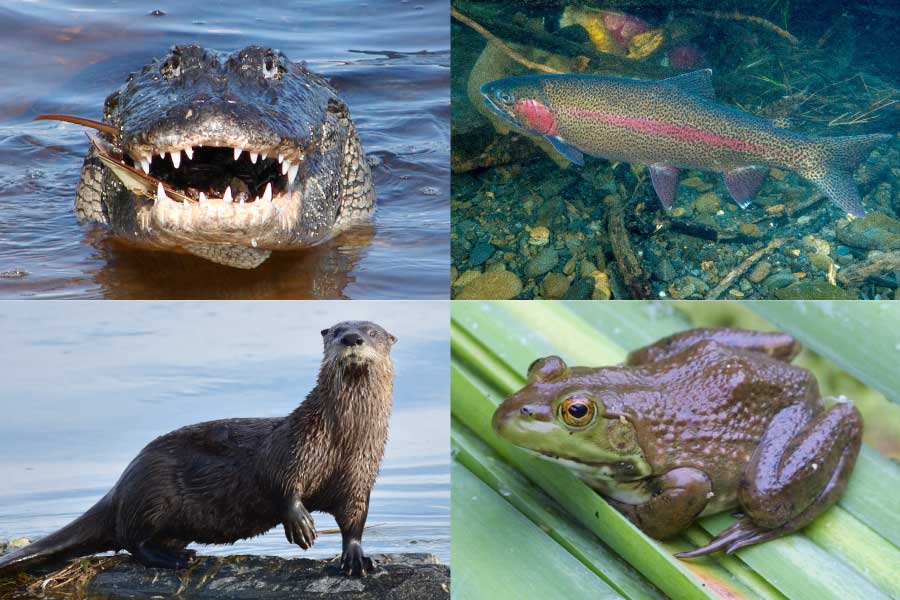
Although nowadays on every continent apart from Antarctica, freshwater habitats make upwardly less than 1% of the world's total area. Despite this, freshwater habitats are home to 10% of all known animals, including up to 40% of all known fish species.
In full, over 100,000 species of establish and animals live in freshwater habitats.
Freshwater makes up only iii% of the h2o on earth, of which two-thirds is frozen in glaciers or otherwise unavailable.
Freshwater Biome Biodiversity
The freshwater biome is highly biodiverse. Animals such equally worms, mollusks, crayfish, and insect larvae couch into the mud found at the bottom of lakes and creeks. Aquatic vegetation provides a habitation to amphibians and aquatic insects (apart from a pocket-size number of possible exceptions, all amphibians are reliant on freshwater).
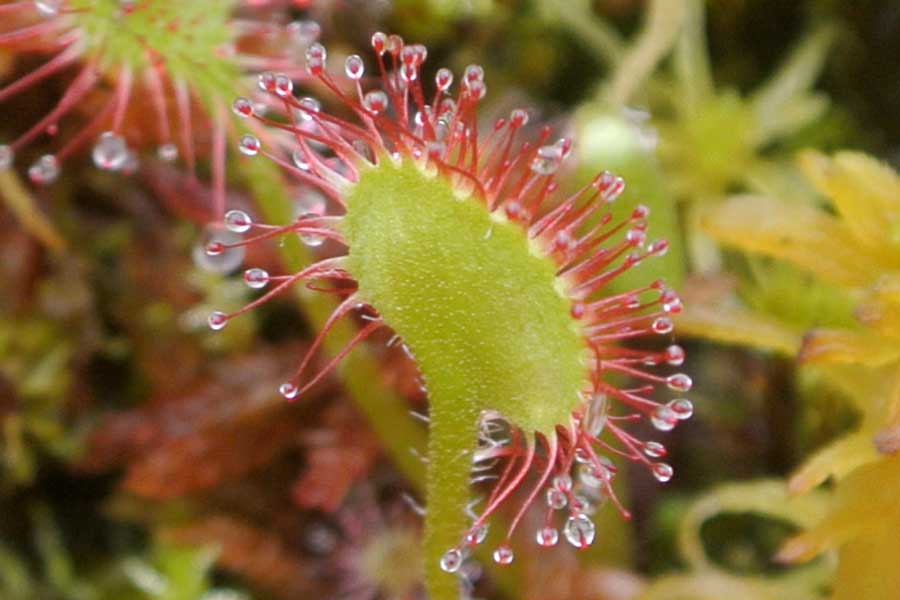
Larger animals, including birds, mammals and reptiles, live in the vegetation that borders expanses of freshwater. Fish are present in many freshwater ecosystems. Wetlands such every bit swamps and marshes are home to an array of specialized plants.
Definition Of Freshwater
Freshwater can be defined equally being water with a depression salt content, or salinity. A common definition of freshwater is water whose dissolved salt content is less than 0.5 parts per m (0.05%).
By comparison, seawater has an average salt content of 34.seven ppt, or three.47%.
The water in freshwater habitats is supplied by the precipitation (rain, hail, or snowfall) of evaporated seawater, or from melted snow and water ice from loftier ground.
Freshwater Habitats
Freshwater habitats include rivers and streams, lakes and ponds, and wetlands such every bit marshes, swamps and bogs.
Rivers and Streams
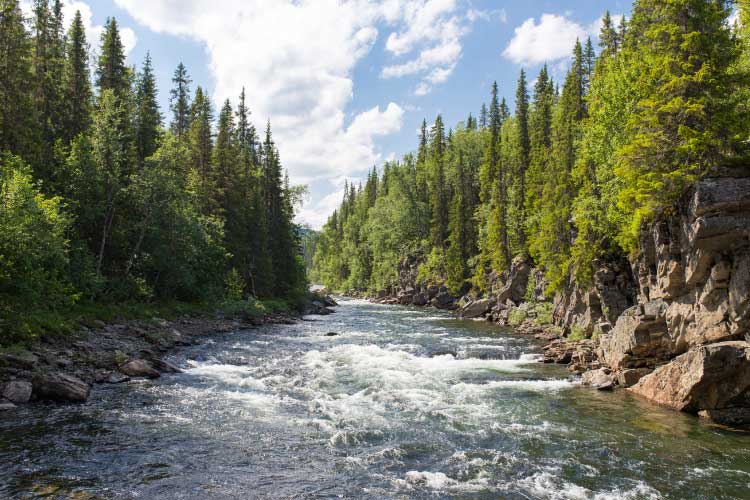
Some of the best-known habitats of the freshwater biome are rivers and streams.
Rivers and streams are flowing, or lotic, freshwater ecosystems, whereas lakes and ponds are even so water, or lentic ecosystems.
Rivers and streams come in all different shapes and sizes, varying not only in length but also in depth, width, rate of flow, and book of water carried. These characteristics are largely adamant by the geography of the area, including the shape of the land and the type of stone over which the river flows.
Rivers and streams are formed either by a spring (groundwater emerging from nether the ground) or by melting snow and ice.
This flowing water forms small creeks and streams, which bring together with other watercourses to course larger rivers.
All rivers eventually flow into the body of water, although their names may alter every bit they merge with other rivers along the mode.
The River Nile, which is in Africa, is generally considered to exist the world'south longest river. Information technology is 4,132 miles (6,650 km) in length. However, by some measurements, Due south America'south Amazon River is considered the world'southward longest river.
The Roe River, in Montana, Usa is recognized as the world'south shortest river. It measures only 201 feet (61 m) in length.
Most of the water flowing in rivers and streams comes from the surrounding country, afterwards originally falling as precipitation. The area whose h2o drains into a river is known every bit a catchment area, or watershed.
Non all rainwater ends up in rivers and streams. Some water evaporates and some of it soaks into the ground to recharge groundwater aquifers (layers of water-containing stone).
Some of the water from these groundwater aquifers will too eventually end up beingness a part of a river or stream. At a sure depth below the earth'due south surface, the ground becomes saturated with h2o; this point is known as the water table. If a riverbank cuts into this saturated footing, equally most rivers exercise, then the water will seep out of the basis into the river.
Lakes and Ponds
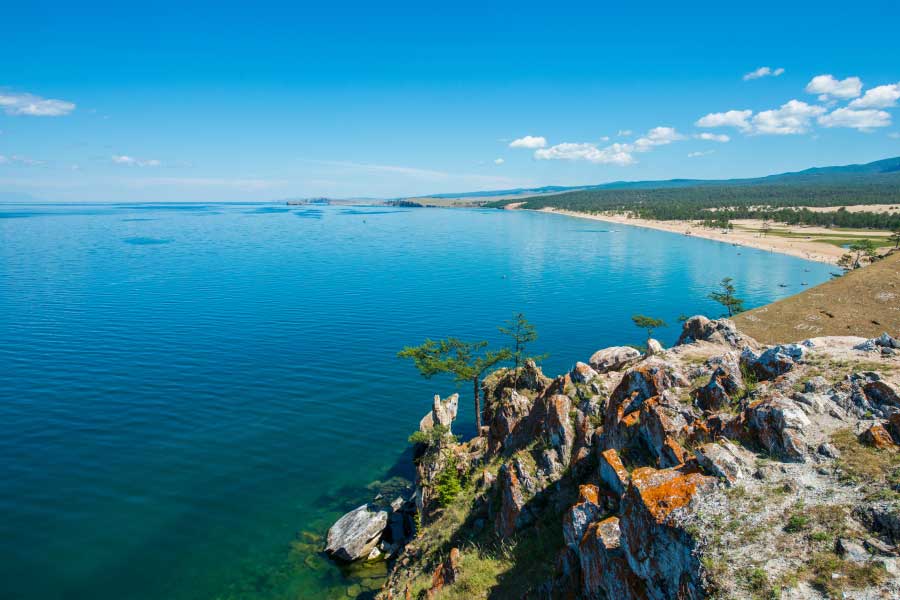
Lakes and ponds are lentic systems. Differing widely in size, depth and the altitude at which they are found, these inland water systems exist in many parts of the world and support to a vast assortment of fauna and flora.
Many lakes were formed by glaciers between 12,000 and 1.8 million years ago, during the last water ice historic period. The moving ice left hollows that later filled with water.
Tectonic movement (the motion of parts of the Earth'south crust) is another manner in which lakes are formed. The movement of tectonic plates tin can create grooves in the Globe'southward surface that fill with water.
Other natural ways in which lakes are formed include: parts of rivers condign cutting off from the chief menstruum; volcano craters filling with h2o; and meteorite strikes that class craters in which water settles.
In addition, many lakes and ponds are man-fabricated. These artificial bodies of water are created for a variety of reasons, including reservoirs, fish farming, sport fishing, recreation, or only for aesthetic reasons. Artificial lakes and ponds can support a broad variety of wild fauna, often in urban areas in which biodiversity is low.
The largest lake in the world in terms of volume is Lake Baikal, which is located in southern Siberia, Russian federation.
Lake Baikal contains around 5,521 cubic miles of water (23,013 cubic kilometers). To put this into context, this volume is approximately equivalent to the combined volume of all five of the North American Great Lakes.
Lake Baikal accounts for approximately 20% of all of Globe's fresh surface h2o. This vast surface area of freshwater was formed by tectonic motion.
North America's Lake Superior is the largest lake in terms of expanse. Its surface expanse is effectually 31,700 sq mi (82,100 km2).
Thermal stratification (dissimilar temperature layers) tin occur in lakes in temperate regions. In summer, h2o near the surface becomes much warmer than the deeper h2o. This tin can atomic number 82 to the deeper water becoming oxygen-depleted.
During the spring and autumn, wind turbulence is higher, which leads to constant mixing of the water and a lessening of the thermal stratification effect.
In the winter, thermal stratification can occur again, particularly in areas that have very cold winter temperatures. In those areas, a layer of common cold-water will grade over a layer of warm water. This is because water density is highest at 4°C and the colder, less dense water will remain at the surface.
This upshot explains why some lakes are covered by a layer of water ice in the winter months.
Lakes and ponds are plant at a variety of elevations and latitudes; equally a result, several thermal stratification patterns are possible.
Lakes found in tropical regions practice not showroom thermal stratification because seasonal temperature variation is small. Similarly, ponds are frequently too shallow to produce thermal stratification.
Wetlands
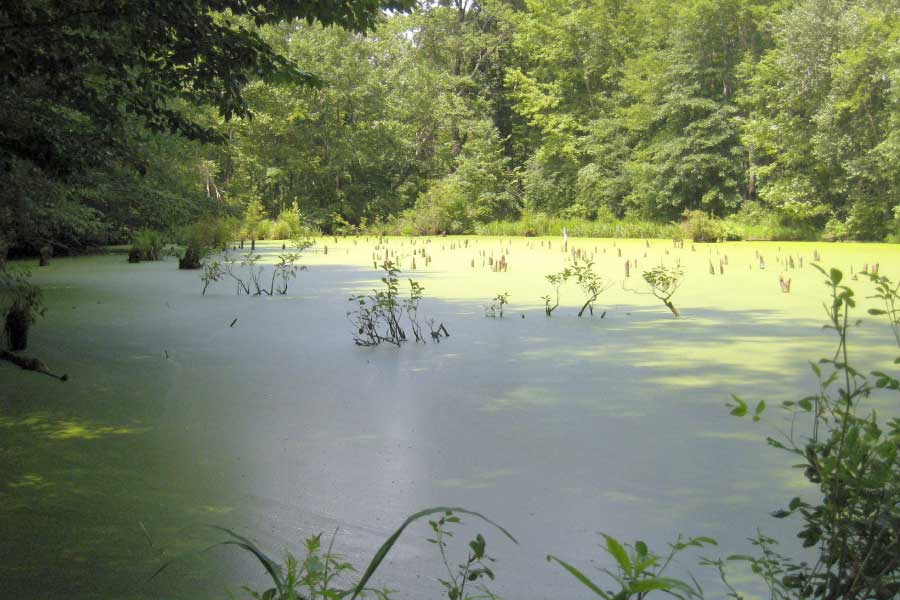
Freshwater wetlands are areas that are covered past freshwater for all or most of the year. Wetland soil is waterlogged and gives rise to a feature range of aquatic vegetation.
The water that supplies wetlands is either floodwater from rivers, lakes, and streams, or groundwater that seeps upwardly through the bedrock underneath the soil.
There are four main types of wetlands: marshes, swamps, bogs and fens.
Marshes are dominated past herbaceous plant species that are adapted to fluctuating water levels. These areas are nutrient-rich, and flora and fauna are arable.
Swamps are dominated by woody plants and trees that take adapted to living in standing water or soil that is constantly saturated with water.
A large number of swamps and marshes have been destroyed by turning their nutrient-rich soil into farmland.
Unlike other wetland ecosystems, bogs are low in nutrients and support a relatively small amount of life. The dominant plants in bogs are sphagnum mosses and heathers. The ground in bogs consists of peat – the remains of thousands of years' worth of sphagnum moss growth. The water in bogs is typically supplied by atmospheric precipitation, and normally acidic.
Fens are waterlogged areas typically found in lowland areas. They are fed by hush-hush and surface h2o. Unlike bogs, the water in fens is either neutral or alkaline metal.
Some wetlands in the northern hemisphere are created past beavers. Past building their characteristic dams, beavers create a wetland habitat that provides them with a prophylactic identify in which to forage.
Importance of Freshwater Habitats
Freshwater is an important resources, non only for humans, but also for the animals and plants that rely on these ecosystems to survive.
Freshwater habitats brand upward less than 1% of the earth's total surface area yet provide a dwelling house for 10% of all known animals, over 25% of all known vertebrate species, 40% of all known fish species, and a vast range of invertebrates and plants.
In total, over 100,000 species of establish and animals live in freshwater habitats.
Freshwater habitats provide us with the majority of the h2o that we employ for drinking, bathing, washing, and irrigation. In addition, we feed on many freshwater plants and animals.
The freshwater biome supplies us with free energy, and is used for send, every bit a means of preventing both erosion and flooding, and the disposal of waste material.
Unfortunately, many of the world's wetlands are existence depleted or irreparably damaged. H2o bodies are becoming polluted and big areas of wetlands are being destroyed for agricultural purposes.
Fewer than 70 of the globe'due south 177 longest rivers remain free of man-made obstructions such every bit dams.
Over the last 50 years, the frequency of severe flooding and drought has increased, partly every bit a effect of harm to freshwater habitats.
Farther Reading
Discover out more virtually biomes on these pages:
- The Forest Biome Facts, Pictures & In-Depth Information
- The Chaparral Biome Facts, Pictures & In-Depth Information
- The Desert Biome: Facts, Characteristics, Types Of Desert, Life In Desert Regions
- The Marine Biome: Facts, Pictures, Ecosystems, Species & Threats
- Grasslands and the Grassland Biome: Facts, Pictures, Plants, Animals, Environmental & Threats
- The Tundra Biome Facts, Pictures & Information. Find The Earth's Coldest, Harshest Biome
- The Taiga Biome: Discover The Boreal Forests Of The Northern Hemisphere
Source: https://www.activewild.com/freshwater-biome/
Posted by: corsochaused.blogspot.com

0 Response to "What Animals Are In The Freshwater Biome"
Post a Comment